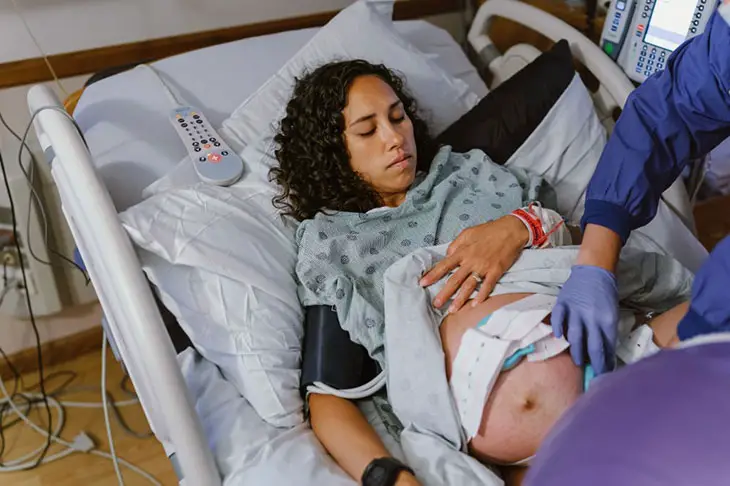Is it ok to induce labor at 39 weeks? As expectant parents or healthcare professionals, it’s essential to be well-informed about this practice.
People have different views on its benefits and risks.
Let’s delve into the reasons for inducing labor at this gestational age, explore the medical conditions that might warrant induction, and examine the primary outcomes for mother and the baby.

Labor induction is a medical process where healthcare providers intentionally start labor instead of waiting for it to happen naturally.
It is usually done when there are concerns about the health of the mother or the baby. Moreover, it’s necessary when the pregnancy has gone beyond the due date.
The process involves using various methods to encourage the uterus to contract and initiate labor. These methods may include:
Medication
Healthcare providers may administer medication to soften and dilate the cervix, preparing it for childbirth.
Breaking the amniotic sac
Doctors sometimes refer to this as “breaking the water.” It involves rupturing the amniotic sac or rupture of membranes to release the amniotic fluid.
This can help uterine contractions for earlier birth.
Cervical ripening balloon
Cervical ripening uses a small balloon-like device inserted into the cervix and inflated. It will help to soften and open the cervix.
Is It Ok To Induce Labor At 39 Weeks?

Yes. Inducing labor at 39 weeks of pregnancy may reduce complications, prevent preeclampsia, and lower C-section rates.
However, you should consider uncertainties in optimal timing, potential neonatal risks beyond 39 weeks of gestation, and cost implications.
Reasons To Induce Labor At 39 Weeks
Reduced Complications
39-week elective induction, especially for low-risk first-time mothers, may reduce the risk of complications for both the mother and the baby.
Studies have suggested infant mortality and complications are lowest when delivery occurs at 39 weeks. Thus, it is a potentially safer option than going beyond the due date.
Preventing Preeclampsia
Inducing labor at the 39th week has been associated with lower rates of preeclampsia. It is a serious condition characterized by high blood pressure disorder during pregnancy.
Preeclampsia can lead to severe complications for both the mother and the baby. Inducing labor earlier are among the benefits for babies to avoid these risks.
Fewer C-Sections
Elective or consecutive induction at 39 weeks of pregnancy has been shown to reduce the number of C-sections.
This can benefit first-time or experienced mothers as cesarean birth involves longer recovery times and carries higher risks than vaginal deliveries.
Perineal Injury Reduction
Perineal injury can be a major concern for many women.
Inducing labor at 39 weeks pregnant is one of the major benefits as it decreases the risk of perineal injury during childbirth.
Reduced Risk Of Intra-Amniotic Infection
Elective induction of labor at 39 weeks lowers risk of intra-amniotic infection than to expectant management (waiting until 40-42 weeks).
Intra-amniotic infection can pose a risk of complications for mother and the baby, so reducing this risk is beneficial.
Reduced Risk Of Blood Transfusion
This 39-week induction also lowers the risk of requiring a blood transfusion or excessive bleeding. The blood flow is also stable.
Thus, avoiding the need for blood transfusion can improve the overall health and recovery of the mother.
Reduced Risk Of Low 5-Minute Apgar Score
Apgar score is a measure of a newborn’s overall health at birth. An Apgar score of 5 or less at 5 minutes after birth is considered low and may indicate potential health issues for the baby.
Elective induction at 39 weeks lowers the risk of low 5-minute Apgar scores. It indicates better newborn health outcomes.
Reasons Not To Induce Labor At 39 Weeks
Uncertain Optimal Timing
The optimal timing for inducing labor is still not entirely clear. The 39 weeks may be advantageous in some cases.
Yet, there is an ongoing debate about whether it is better to wait until spontaneous labor occurs or induce labor at a later stage, such as 41 weeks.
Increased Neonatal Deaths/ Infant death
One of the bad outcomes is a slight increase in newborn deaths for deliveries occurring later than 39-week induction.
The difference may not always be significant. However, this neonatal outcome raises concerns about the potential risks of delaying delivery.
Cost And Resource Implications
Inducing labor may increase costs and expand labor durations more than natural delivery.
Managing the potential increase in inductions, intensive care units, and resource usage may pose challenges for some healthcare centers.
Lack Of Generalizability
The induction study involved many healthy women or low-risk women from different hospitals.
However, the results only apply to a specific group of uncomplicated pregnancies with known due dates.
The findings may not be true for all pregnant women with different health issues or pregnancy histories.
Positive Outcomes Of Labor Babies At 39 Weeks
Babies born at 39 weeks have the following good things:
- Organs are ready: Unlike babies born at 35 weeks by induced labor, babies at 39 weeks have fully developed organs like the brain, lungs, and liver.
- Fewer health problems: Another positive perinatal outcome is that babies are less likely to have issues with breathing, vision, and hearing problems after birth.
- Healthy weight: Fetal monitoring shows that babies born at 39 weeks usually have a good weight, which helps them stay warm and healthy.
- Easier feeding and sleep: They can eat and stay awake better after birth and don’t need extra care in birth centers.
- Less long-term problems: They have a lower chance of health problems later in life than premature babies.
FAQs

What Happens If Induction Does Not Work?
If medical induction doesn’t work and you and your baby are fine, you might be sent home and asked to return later for another try.
But in case your labor starts naturally, you should return to the hospital.
If there are concerns about you or your baby’s health during induction, a cesarean delivery might be needed for a safe birth.
Will Hospitals Offer Induction At 39 Weeks?
Yes. But not all hospitals will offer induction at 39 weeks. It depends on whether they have the staff and resources to do it safely.
Talk to your health care provider to determine if this is available in your hospital.
What Are The Risks Of Labor Induction?
Labor induction is safe, but it also has some risk factors you need to know:
Overstimulation of the uterus: Some induction methods can cause the uterus to contract too frequently.
It may trigger too many labor contractions, stressing the baby and affecting their heart rate.
Changes in fetal heart rate: Overstimulation of the uterus can result in changes in the baby’s heart rate, which may be a sign of distress.
Infection: There is a risk of infection for the pregnant person and her baby during cervical ripening and labor induction.
Conclusion
Is it ok to induce labor at 39 weeks? Yes. It may reduce certain problems, such as birth complications and maternal complications, and make childbirth safer.
However, not all pregnancies may be right for induction at 39 weeks.
Thus, it’s best to talk openly with doctors to find the best plan and the optimal time for the health of the mother and baby.
